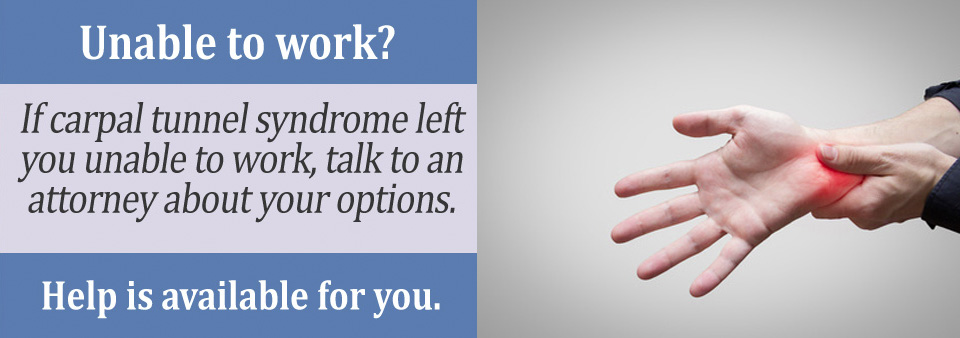Carpal tunnel sydrome is one of the most commonly-diagnosed nerve disorders in the U.S. However, for those with severe Carpal Tunnel Syndrome (CTS), this disorder can be debilitating.
Symptoms like weakness, numbness, and shooting pain up to the shoulder in one or both hands can happen in the worst cases. For those who experience these symptoms, completing normal daily tasks like cooking, cleaning, working, or even just getting around can be dangerous and/or painful.
If this is the case for you, then you may qualify for financial and medical assistance from the Social Security Administration. Though the process can be tricky, those with proper paperwork, testing, and persistence can qualify for disability benefits through the government.
Understanding the Blue Book
The most important (and most difficult) aspect of applying for benefits is figuring out how to qualify. The best place to start is with the Social Security Administration’s “Blue Book.”
This book is a medical reference for Social Security reviewers to follow when determining if an applicant’s condition is severe enough to qualify as “totally and permanently disabled.” This phrase refers to those whose condition:
a) is severe enough to prevent them from living and working normally, and
b) is expected to last at least 12 months or result in death.
Applying under the Blue Book can be difficult for those with CTS because there is no official listing for the disorder. This is because the majority of people with carpal tunnel see improvement over time or with corrective treatment; as a result, the SSA may hesitate when awarding benefits.
However, with proper documentation, you can still qualify for benefits in a few different ways.
How to Qualify with Carpal Tunnel
Although there is no official listing for CTS, you may be able to get benefits by:
- Meeting the requirements of another listing. Carpal tunnel results from severe nerve compression in the wrist. This is a form of “mononeuropathy,” which can occur anywhere in the body where damaged nerves reside. The Blue Book contains a listing for damaged nerves under Section 11.14: “Peripheral Neuropathy,” which states that applicants can qualify for benefits if they demonstrate:
- An inability to properly control or use two extremities (“disorganization of motor function”) resulting in an extreme limitation of walking, sitting, standing up, balancing, or using the upper extremities, OR
- Marked limitation in physical functioning as well as with either a) understanding, remembering, or applying information, b) interacting with others, c) concentrating, persisting, or maintaining pace, or d) adapting or managing oneself.
- Qualifying for a Medical Vocational Allowance: In most cases, even people with severe CTS may have trouble meeting a Blue Book listing. However, a Medical Vocational Allowance (MVA) allows an applicant to receive benefits anyway. To qualify for an MVA, you must prove that your symptoms are still severe enough to prevent you from returning to regular work and supporting yourself financially.
This is most common in applicants who have little education, or who have spent their whole lives working in a field that CTS prevents them doing. For example, a professional seamstress or craftsman (i.e., people who largely rely on their hands to work) may be unable to find continued work due to their condition, which would make them more likely to qualify for an MVA.

Preparing for the Application
After you get familiar with the application process, the most important part of your disability application will be making sure all of your paperwork and test results are in order. In general, the more evidence you provide regarding the extent of your condition on your application, the more likely you are to qualify for benefits.
As a first course of action, speak with your physician and acquire the following test results that can show your CTS diagnosis:
- Regular physical exam notes: More often than not, CTS is diagnosed with a physical exam. Regular exam notes over time can demonstrate a worsening or stagnation of a severe diagnosis.
- Nerve conduction tests: Nerve conduction tests may be important to test your remaining nerve function in these areas, especially if your CTS is severe enough to cause pain in areas outside of the wrist.
- Non-surgical treatment history: Most cases of carpal tunnel are treated with a combination of splints, anti-inflammatory medications, and/or vitamin supplements. However, proving that your CTS did not respond to these treatments is a good way to communicate its severity to the SSA.
- Surgical treatment history: In 90% of cases, those who receive carpal ligament surgery see relief after healing is complete. However, in rare cases, surgery can take up to 14 months to heal properly, or never heal completely. This information is especially useful to provide on your application.
- RFC tests: An RFC test is especially necessary for those who feel an MVA is their best shot at getting benefits. This test measures a person’s ability to function normally with tasks like sitting, standing, walking, lifting, or pushing. Those with lower scores are considered less likely to work reliably and more likely to receive benefits.
Considering a Disability Attorney
Getting benefits for a disorder like CTS can difficult. If you are concerned about your qualifications or the application process, then it may be best to schedule a free consultation with a disability attorney
That attorney's experience in the business can help you when organizing paperwork, staying in contact with the SSA, and potentially building a case to present to an administrative law judge during an appeal. Better yet, most attorneys do not take payment for their services unless they help you win your case.